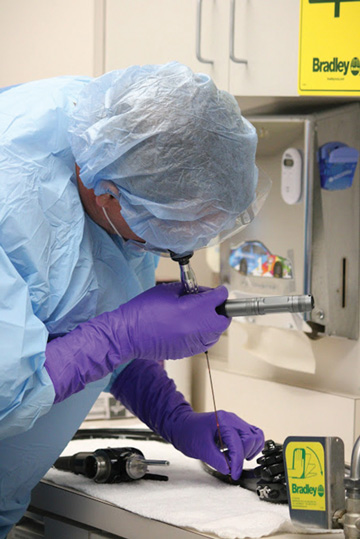• Engaged staff. Focus on providing consistent training for the surgical team members and reprocessing technicians who are charged with caring for instruments. “Ultimately, sterilization comes down to quality management,
and that begins with the education and training of your staff,” says Alison Sonstelie, BS, CRCST, CHL, CIS, client success manager at Ascendco Health, a healthcare data, analytics and software company headquartered in Chicago.
She recommends designating a point person on staff to manage the quality monitoring of your sterilization processes. “That person can train staff on proper monitoring and cleaning techniques and keep tabs on problem events,” she
says.
Mr. Balch urges facility leaders to put more of an emphasis on whom they hire to work in sterile processing. “You need a team of empowered and engaged technicians who are constantly looking at the process around them and asking, ‘Why?’”
he says. “This kind of team doesn’t develop on its own. It must be recruited, cultivated and retained over time.”
Grassroots quality management happens when these critical thinkers are given the leadership support they need to identify, propose and implement changes to their department’s workflows. “That’s where the magic happens,”
says Mr. Balch.
• Standardized processes. When you break down the many steps of proper instrument care — from point-of-use treatments and decontamination to assembly and sterilization — you grasp the importance of standardizing the
process. While your sterile processing staff must adhere to the steps outlined in the instructions for use (IFU) of devices and equipment, that doesn’t mean they can’t go beyond the bare minimum and create their own standardized
workflow — coupled with easy-to-track metrics — to maximize the safety and efficiency of how they work in practice.
The best way to standardize instrument workflow is to collaborate with the techs who are doing the job day in and day out. “Listen to their suggestions and be willing to trial the ideas they come up with,” says Jig Patel, ST, CRCST,
CHL, CIS, CER, sterile processing educator and quality manager at UCLA Health in Los Angeles. “The people who do the work constantly think about how things can be done better.”
If an instrument isn’t clean, it can never be sterile.
— Jig Patel
• Spot audits. Even the most carefully planned procedures have occasional gaps and blind spots. “Monitoring is the most important step in the sterilization process,” says Ms. Sonstelie. “You need to track performance
data for defects in the process because today’s instruments and devices are difficult to clean and sterilize, even for a fully trained staff who follow IFUs to the letter.”
Ms. Sonstelie believes performance monitoring must be objective and involve root cause analyses of the most critical trends identified. Otherwise, the entire tracking process becomes subjective. “This happens often,” she says.
“Relatively minor issues like missing sterilization indicators are given the same importance as, say, not testing the insulation on laparoscopic instruments.”
It’s important to get out ahead of problem areas, set concrete audit goals and be proactive in the ways in which staff target problems, according to Ms. Sonstelie, who adds, “That said, facilities must begin with what they can
handle.” She suggests starting small in developing specific audit goals based on the auditing practices recommended by instrument manufacturers.
Mr. Patel insists his staff spends quality time inspecting instruments to ensure they’ve been properly cared for before they’re returned to the ORs. “If an instrument isn’t clean, it can never be sterile,” he
says.
There’s no shortage of innovative technology on the market to supplement the manual cleaning efforts of your hardworking reprocessing techs (see “Real-Time Checks of Proper Instrument Care” below). Still, it’s
important for surgical leaders to remember that the latest tools are meant to complement manual processes. “Facilities that don’t have solid, standardized practices in place rely on technology to replace manual cleaning,”
says Ms. Sonstelie. “But solid manual processes are always superior to technology alone.” OSM
.svg?sfvrsn=be606e78_3)

.svg?sfvrsn=56b2f850_5)